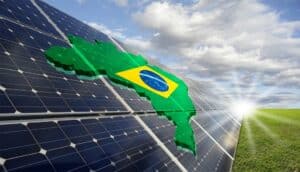The Brazilian photovoltaic solar energy sector has achieved some important advances, but still expects more favorable conditions for full development.
Recently, Brazil reached the new mark of 350 megawatts (MW) of installed power in microgeneration systems and solar distributed minigeneration.
Despite considering it an important achievement, the CEO of the Brazilian Association of Photovoltaic Solar Energy (Absolar), Rodrigo Sauaia, sees potential for even greater growth.

“Our country has just under 40,000 small systems. Meanwhile, there are countries that have already passed the 1 million barrier and others are approaching the 2 million mark,” he said. He also mentions that Brazil is starting to manufacture photovoltaic equipment, but that companies need greater incentives.
“There is still a high and unfair tax burden on productive inputs”, he reveals. Sauaia also spoke about how the sector will deal with the environmental issue and the sustainability. “The sector has an international recycling program, which demonstrates that it is possible to recycle 96% from the components of a photovoltaic equipment”, he replied when asked about the destination of the modules after the end of their useful life.
What has helped in the growth of solar in Brazil?
There are some of the main factors that allowed Brazil to reach this mark of 350 MW. The first is related to the price of photovoltaic solar energy. Over the past decade, technology has become cheaper 80%. This is a great gain in competitiveness, which made the source more accessible to the population, companies and governments.
The second important factor was the increase in the electricity tariff, which has increased significantly and weighed heavily on the population, at rates well above inflation. To give you an idea, last year, average inflation was 2.95% per year, while electricity increased by 10% in the year. In 2018, experts project that the readjustment of electricity will be between 10% and 15%, on average. In some states, this readjustment is even greater. Minas Gerais had an increase of 25% of readjustment this year. All of this puts pressure on consumers to look for alternatives and ways to save money.
What is the role of domestic consumers in solar expansion? Have they been leading this growth?
If, in terms of the number of consumer units, the segment we call residential has led, on the other hand, when we look at the volume of investment and installed power, the first place goes to commerce and service providers, which represent almost 44% of all investments and installed capacity. These two segments [commercial and residential] together, as well as micro and small industries, are those that pay the most expensive electricity in Brazil. And, therefore, they must continue to lead the use of photovoltaic solar energy.
The small rural producer also appears on this list, but he has some slightly different characteristics. Normally, energy in rural areas has a lower value. Other factors, in addition to the economic, lead the producer to worry a lot about generating his own energy. Often, to bring energy to a region where there is no access to electricity, they can use solar photovoltaics for greater stability in the energy supply.


